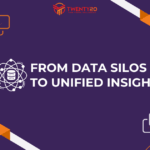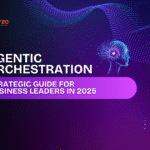
From Data Silos to Unified Insights: Gaining the Competitive Edge in Uncertain Times
June 18, 2025
Agentic Orchestration: Strategic Guide for Business Leaders in 2025
August 28, 2025
From Data Silos to Unified Insights: Gaining the Competitive Edge in Uncertain Times
June 18, 2025
Agentic Orchestration: Strategic Guide for Business Leaders in 2025
August 28, 2025Migrating from Pega to Workato: A Strategic Guide for Enterprise Automation
When I first got pulled into a project to migrate a suite of workflows from Pega to Workato, I wasn’t sure what to expect. Having worked extensively with Pega’s case management systems, I knew we were dealing with a platform built for structure, compliance, and control. It was never just about automation — it was about tracking every step in a defined, rule-driven process.
But the business had started to shift. They needed faster integration between cloud systems, more agile automation, and fewer dependencies on specialized IT teams. That’s when Workato entered the conversation.
At first, it felt like we were comparing apples to oranges. Workato isn’t a BPM platform — it’s a low-code iPaaS that thrives on speed, flexibility, and simplicity. But over time, I realized this wasn’t just a migration — it was a mindset shift. One that required rethinking how we design workflows, who owns them, and how quickly we could deploy them.
In this blog, I’ll share how we approached the migration, what patterns helped us succeed, and what I wish I’d known before we started. Whether you're a developer, an automation architect, or a platform owner, I hope these insights help you avoid the pitfalls we encountered and capitalize on the opportunities we discovered.
Why Organizations Are Rethinking Their Automation Stack
Many organizations implemented Pega over the past decade for its robust BPM and case management capabilities. However, today’s automation needs are different:
- Faster Time-to-Market for integrations
- Decentralized ownership of automation (not just IT)
- Seamless SaaS connectivity with platforms like Salesforce, Slack, NetSuite, and Zendesk
- Low-code/no-code environments that enable agile experimentation
While Pega remains strong in heavily regulated, process-intensive environments, it can be rigid and developer-dependent when scaling automation across business units. This has led many enterprises to explore more agile platforms like Workato that balance governance with business agility.
Understanding the Platform Shift: Pega and Workato in Context
Before embarking on a migration, it’s important to recognize that Pega and Workato serve different operational philosophies:

Instead of attempting a one-to-one replacement, treat this migration as a replatforming opportunity that leverages Workato’s strengths for modern automation while acknowledging the BPM depth that Pega offers.
What to Migrate: Identifying Workloads Suitable for Workato
Migrating from Pega to Workato requires selecting workflows that align with each platform's strengths. Workato is optimized for fast, scalable integration and automation, while Pega excels in structured, compliance-heavy BPM use cases.
Here’s a concise comparison:

What to Migrate
- SaaS integrations between CRM, ERP, HRMS, ITSM, etc.
- Event-driven automation (e.g., onboarding, lead routing)
- Periodic or scheduled jobs without complex state tracking
What to Retain in Pega
- Long-running workflows with SLAs and compliance gates
- Decisioning logic using rule sets, decision tables
- Structured user interfaces and guided human interaction
This isn't a like-for-like migration — it’s a strategic replatforming. Use each tool where it performs best to create a more agile, modern automation stack.
Migration Strategy: A Phased, Practical Approach
Because Pega and Workato follow fundamentally different logic models, the migration must be designed thoughtfully, not just executed technically.

1. Discovery & Audit
- Document all current processes in Pega
- Identify existing system integrations, user roles, business rules, SLAs
- Classify each process by automation potential and business impact
2. Redesign for Workato
- Translate workflows into modular Recipes instead of monolithic cases
- Replace complex logic with conditional flows and reusable components
- Use Workato connectors to abstract API complexity
3. Build & Test
- Use agile sprints to rebuild and validate automations
- Involve business users early to test workflows using Workato’s visual builder
- Implement fail-safes, alerts, and logging for reliability
Key Considerations for a Successful Migration
Architecture Planning
Workato isn’t just a tool — it’s an automation layer. Design your integration landscape with future scale in mind: authentication, error handling, retries, queueing, and versioning.
Change Management
Migrations aren’t just technical — they’re cultural. Prepare teams with walkthroughs, documentation, and sandbox environments to encourage adoption.
Security & Compliance
Workato supports OAuth, token-based access, and role-based access controls. Align your deployment with InfoSec standards and audit needs.
Testing at Scale
Automated processes can fail silently. Set up test environments and staging Recipes to ensure no business logic breaks during or post-migration.
Realizing Value with Workato: Beyond Migration
Migration is just the beginning. With Workato, enterprises can:
- Automate lead routing from website to CRM in real time
- Trigger HR workflows when an offer letter is signed
- Sync finance data from ERP to business intelligence dashboards
- Alert teams via Slack or Teams when exceptions occur
What used to take months of Pega configuration can now be delivered in weeks with Workato’s visual builder and pre-built recipes.
Enablement: Empowering Teams Post-Migration
To sustain long-term success:
- Empower teams through Workato’s Automation Institute or tailored internal training programs
- Set up governance frameworks to manage automation sprawl
- Establish Centers of Excellence (CoEs) for ongoing development and optimization
Final Thoughts: Choosing the Right Tool for the Right Task
Migrating from Pega to Workato isn’t about choosing the “better” tool — it’s about choosing the right platform for the right use case.
- Use Pega where business process modeling, structured decisioning, process transparency, and audit-ready workflows are central to operations.
- Use Workato where API-led integration, event-based automation, and scalable orchestration across tools and teams drive competitive value.
For most modern enterprises, a hybrid approach works best: retain legacy BPM workflows where needed, and use Workato to power modern, agile automation.
Ready to Migrate?
At Twenty20 Systems, we help enterprises reimagine automation. Whether you're planning a full migration or exploring a hybrid automation strategy, our experts can guide you every step of the way.
Get in touch to talk about your automation roadmap.
About the Authors
Gowtham M
Meet Gowtham M, our Integration Specialist and Senior Software Engineer at Twenty20 Systems, who specializes in building seamless, high-impact integration solutions using MuleSoft. With deep expertise in API development, data transformation, and system connectivity, Gowtham ensures that business applications communicate effortlessly and securely. His focus on scalable, high-quality implementations has helped streamline critical processes across enterprise environments. Passionate about solving complex integration challenges, Gowtham brings both precision and innovation to every solution he crafts.


